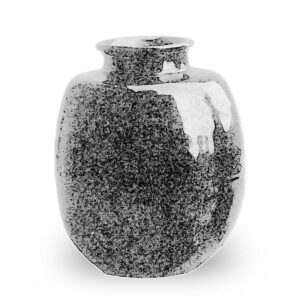
A great masterpiece. This is a karamono kagatatsuki tea caddy. The twist back at the mouth edge is a little deep and there is a line around the steamer. The shoulders are tight, and the body gradually becomes tauter from the body to the waist, while the area from the hem and below becomes fuller and narrower. The clay is rat-colored, and the threads are cut finely and there are some discrepancies at the starting point. There is one small fraying and one small snag. The body is beautifully glazed with black candy glaze. The body has a slightly large chinki-stripe on the body that extends over two thirds of the tea container. The right hand side of the okiagata is covered with a persimmon-gold glaze from the shoulder to the hem, and there is a black glaze border with persimmon-gold under the body strap. Also on the right side of the okiagata is a blue glazed slip with a black candy border, which adds an additional layer of scenery. The overall appearance is a mixture of yellow glaze, blue glaze, and persimmon color, and the changes in scenery are difficult to describe. This piece is one of the rarest of all Chinese small shoulder implements, but it is particularly auspicious in terms of both shape and glaze color, and is worthy of competing with the Mt. This piece was given to Date Masamune by Tokugawa Ieyasu in 1599. During the Tempo era (1830-1444), it was entrusted to the Sendai family Kanakata Sumiyasu in Osaka, together with Higuchi kashirazu, kiba-zaru, ash, etc. It is said that an envoy was dispatched from the Marquis Date to Sumiyasu every year on the occasion of the Bakuryo festival. After the Meiji Restoration, it was placed in the Iwasaki family’s collection along with the Higuchi kagashu. (Gankan Meimono Ki, Kokin Meimono Ruiju, Kokeimono Ki, Taisho Meikikan)



